Mary Richardson
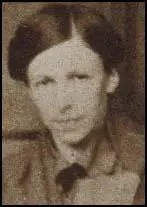
Mary Raleigh Richardson was born in England in 1882 but was brought up by her Canadian mother in Belleville, Ontario. She returned to Britain when she was sixteen, studying art and travelling to France and Italy. While living in Bloomsbury she became a journalist. (1)
On 18th November, 1910 the Women's Social and Political Union (WSPU) lobbied Parliament. She witnessed the way the police brutally attacked the women. She immediately joined the WSPU and quickly engaged in militant activities. She later described this as "a holy crusade". (2)
Over the next few years she was arrested nine times, serving several sentences in Holloway Prison for assaulting the police and breaking windows. She has been described "as one of the most militant suffragettes, who was arrested nine times and was one of the first two suffragettes to be forcibly fed". (3)
On one occasion Mary Richardson was asked by the prison doctor whether she would refrain from militancy on her release, she answered: "I shall be militant as long as I can stand or see; they cannot do more than kill me." He replied: "It is not a question of killing you... you will be kept till you are a skeleton, and a nervous and mental wreck, and then you will be sent to an institution where they look after mental wrecks." (4)
Mary Richardson: Arson Campaign
Emmeline Pankhurst gave permission for her daughter, Christabel Pankhurst, to launch a secret arson campaign. She knew that she was likely to be arrested and so she decided to move to Paris. Attempts were made by suffragettes to burn down the houses of two members of the government who opposed women having the vote. These attempts failed but soon afterwards, a house being built for David Lloyd George, the Chancellor of the Exchequer, was badly damaged by suffragettes. (5) It is believed that Richardson was responsible for setting fire to The Elms, a house owned by Rosalind Howard, Countess of Carlisle. (6)
Mary Richardson later recalled the first time she set fire to a building: "I took the things from her and went on to the mansion. The putty of one of the ground-floor windows was old and broke away easily, and I had soon knocked out a large pane of the glass. When I climbed inside into the blackness it was a horrible moment. The place was frighteningly strange and pitch dark, smelling of damp and decay... A ghastly fear took possession of me; and, when my face wiped against a cobweb, I was momentarily stiff with fright. But I knew how to lay a fire - I had built many a camp fire in my young days -a nd that part of the work was simple and quickly done. I poured the inflammable liquid over everything; then I made a long fuse of twisted cotton wool, soaking that too as I unwound it and slowly made my way back to the window at which I had entered." (7)
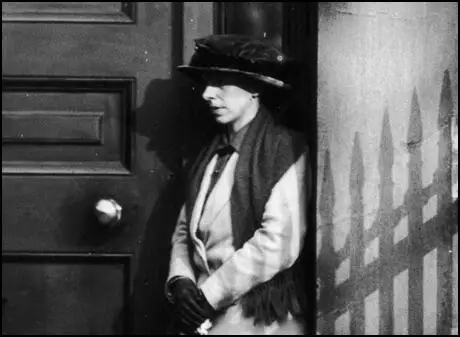
In June, 1913, Richardson attended the most important race of the year, the Derby, with Emily Davison: "A minute before the race started she raised a paper on her own or some kind of card before her eyes. I was watching her hand. It did not shake. Even when I heard the pounding of the horses' hoofs moving closer I saw she was still smiling. And suddenly she slipped under the rail and ran out into the middle of the racecourse. It was all over so quickly." Davison ran out on the course and attempted to grab the bridle of Anmer, a horse owned by King George V. The horse hit Emily and the impact fractured her skull and she died on 8th June without regaining consciousness. (8) Richardson escaped to "Epsom Station where a sympathetic station master hid her in the ladies' loo until the hue and cry were over". (9)
On 18th July, 1913, Mary Richardson was sentenced to a month's hard labour for throwing an inkpot through a window of a police station. She went on hunger strike and was released five days later as a result of the Cat & Mouse Act. As soon as she recovered she was arrested again. Every time she was released she carried out another act of violence. (10)
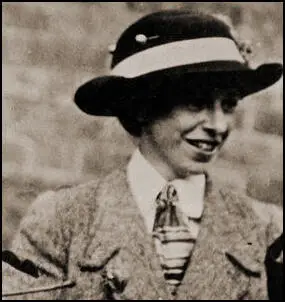
In 1913 the WSPU arson campaign escalated and railway stations, cricket pavilions, racecourse stands and golf clubhouses being set on fire. Slogans in favour of women's suffrage were cut and burned into the turf. Suffragettes also cut telephone wires and destroyed letters by pouring chemicals into post boxes. The women responsible were often caught and once in prison they went on hunger-strike. Richardson was arrested at the scene of an arson attack. She suffered extensive bruising and poor health as a result of being forced-fed. After being released in 1914 she was operated on for appendicitis. (11)
Rokeby Venus
On 10 March 1914 she attacked a painting, Rokeby Venus by Diego Velázquez at the National Gallery. She later described what happened: "I dashed up to the painting. My first blow with the axe merely broke the protective glass. But, Of course, it did more than that, for the detective rose with his newspaper still in his hand and walked round the red plush seat, staring up at the skylight which was being repaired. The sound of the glass breaking also attracted the attention of the attendant at the door who, in his frantic efforts to reach me, slipped on the highly polished floor and fell face downward. And so I was given time to get in a further four blows with my axe before I was, in turn, attacked." (12)
The Manchester Guardian reported the following day: "At the National Gallery, yesterday morning, the famous Rokeby Venus, the Velasquez picture which eight years ago was bought for the nation by public subscription for £45,000, was seriously damaged by a militant suffragist connected with the Women's Social and Political Union... The woman, producing a meat chopper from her muff or cloak, smashed the glass of the picture, and rained blows upon the back of the Venus. A police officer was at the door of the room, and a gallery attendant also heard the smashing of the glass. They rushed towards the woman, but before they could seize her she had made seven cuts in the canvas." (13) Later she revealed that she hated the way nude paintings were "gloated over by men". (14)
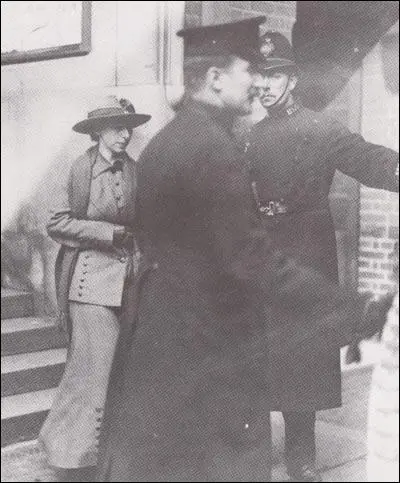
Several members of the Women Social & Political Union became critical of her action and left the organisation. Laurence Housman, one of the co-founders of the Suffrage Atelier was especially critical of Richardson. Housman described the "stab in the back given to the Rokeby Venus" as hurting his artistic feelings. "After that came the burning of churches, and I felt myself obliged to cease subscribing to WSPU funds." (15)
Richardson claimed that this act was perpetrated to draw attention to the plight of Emmeline Pankhurst, then on hunger strike in Holloway Prison, saying, "I should like to point out that the outrage which the Government has committed upon Mrs. Pankhurst is an ultimatum of outrages. It is murder, slow murder, and premeditated murder... You can get another picture but you cannot get a life, as they are killing Mrs Pankhurst". She was found guilty and sentenced to eighteen months with hard labour. It also led to many museums' closing their doors to unaccompanied women. (16)
While in prison she wrote about the condition of prisoners such as Grace Roe, Hilda Burkitt and Florence Tunks. "I was in the next cell to Grace Roe since her conviction and had frequent conversations with her. I consider her the most injured by forcible feeding of any in Holloway… Grace suffers extremely from pain in her nose, throat and stomach all day and night, says she feels as if the tube were always in her body. She says that mentally this is telling on her, and she sometimes feels something would crack in her brain. She anticipates an utter collapse on her release. She is very thin, so thin she can be in no position without positive pain in her bones; she is frightfully anaemic and says her gums are chalk white, and indeed her whole face is… In wing C, within calling distance is Hilda Burkitt who is very weak now. She has lost a stone. She is sick with each feeding. She has been fed four times a day for over a fortnight at nine, twelve, four, and eight o'clock. Next to her is Florence Tunks. She has lost twenty-seven and a half-pounds, has had two teeth broken, is generally exhausted, and cannot stand without giddiness for more than a few minutes. (17)
On her release from prison Richardson resumed her literary career, publishing a novel, Matilda and Marcus (1915), and two volumes of poetry, Symbol Songs (1916) and Wilderness Love Songs (1917). Her third book of poetry, Cornish Headlands, appeared in 1920. (18)
In the 1922 General Election when she stood as Labour Party candidate in Acton, obtaining 26.2 per cent of the vote. In the 1924 General Election she stood for the same seat as an independent socialist against the official Labour candidate and received 7.6 per cent of the vote. In 1931 General Election she was adopted as a last-minute Labour candidate in Aldershot but lost heavily. (19)
British Union of Fascists
In January 1932 Oswald Mosley met Benito Mussolini in Italy. Mosley was impressed by Mussolini's achievements and when he returned to England he established the British Union of Fascists (BUF). Mary Richardson was one of those who joined the BUP: "I was first attracted to the Blackshirts because I saw in them the courage, the action, the loyalty, the gift of service, and the ability to serve which I had known in the suffragette movement". She also liked "its policy of Imperialism, and action combined with discipline which raise the movement above comparison with the present party system." (20)
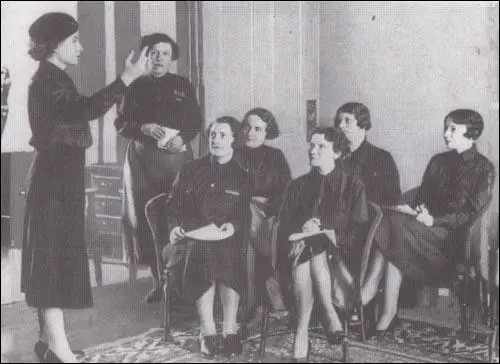
for women members of the British Union of Fascists.
Other former suffragettes who joined included Norah Dacre Fox, Mary Allen and Mercedes Barrington. It has been argued by Julie V. Gottlieb, the author of Feminine Fascism: Women in Britain's Fascist Movement (2003) that some militant suffragettes "settled into the seemingly inhospitable territory of British fascism during the 1930s" because of "their disillusionment with the post-war condition of the women's movement in the aftermath of female enfranchisement". (21)
Emmeline Pethick-Lawrence, a former leader of the Women's Social and Political Union (WSPU), expressed regret that some of its former members were active in the BUF but admitted that both organizations "bore a certain resemblance to the dictatorship so common in the world today... it is so-called upholders of democracy who create, when they are false in their principles, and when they attempt to crush their opponents, dictatorships". (22)
In April 1934 Richardson replaced Lady Esther Makgill as head of the Women's Section. "Although the organisation obviously included many anti-feminist men, it seems clear that the female members of the BUF played a very active role... The women, who appeared prominently at fascist functions, have been estimated to comprise a quarter of the total membership. They wore a black blouse, black beret and grey skirt." (23)
In 1953 Mary Richardson published her autobiography, Laugh a Defiance. Although she wrote in detail about her experiences in the Women's Social and Political Union she failed to mention her membership of the British Union of Fascists. (24)
Mary Richardson died of heart failure and bronchitis, aged seventy-eight, at her home in Hastings on 7th November 1961.
Primary Sources
(1) Mary Richardson, Laugh a Defiance (1953)
I took the things from her and went on to the mansion. The putty of one of the ground-floor windows was old and broke away easily, and I had soon knocked out a large pane of the glass. When I climbed inside into the blackness it was a horrible moment. The place was frighteningly strange and pitch dark, smelling of damp and decay. I had to feel my way along, step by step, encumbered, as I was, by the three heavy parcels I had slung round my neck. After much groping I reached the hallway and knew I was near my objective. This was a cupboard under the main staircase.
To get the cupboard door to open was no easy thing. The hinges were rusted and they creaked and groaned ominously. A ghastly fear took possession of me; and, when my face wiped against a cobweb, I was momentarily stiff with fright. But I knew how to lay a fire - I had built many a camp fire in my young days-and that part of the work was simple and quickly done. I poured the inflammable liquid over everything; then I made a long fuse of twisted cotton wool, soaking that too as I unwound it and slowly made my way back to the window at which I had entered.
I climbed outside before setting a light to the fuse. For a moment I stood and watched the tiny flame run a few feet; then I hurried off to find the gap in the thorn hedge. When I did find it and crawled through, Millicent had fled.
I bumped into Millicent as she was hurrying back to find me.
"I'm terribly sorry," she explained. "I just couldn't...."She stopped short and looked back behind us; I looked back, also. The red glow had grown into a huge red mushroom.
"We must get away quickly," I gasped. "We'd better separate. If we're alone it'll look less suspicious; and it'll be easier for one to get a lift in a market-gardener's cart going to Covent Garden. I'll go this way; you make your way back to the road."
Millicent clutched at my arm and burst into tears. "Oh no. No! No! Please let me come with you. I'd never find my way alone. Oh please, I feel so frightened."
"Very well," I said. "But it's a risk. And we'll have to hurry."
We went as fast as we could; but we were both groggy from fatigue and the mental strain of the whole, ugly business. After a while we heard the clanging of the bells on the fire-engines. We staggered on and made renewed efforts to get as far away as we could. For a long time we seemed to be walking along outside a high wall.
"It must be a gasworks," I said.
We kept on walking beside the wall. Millicent was unable to answer me or even to say yes or no. The fog was becoming denser; and we were still outside the wall. I began to feel we were condemned to walk beside it for ever in punishment for our sins. But at last we came to what seemed to be a residential quarter. There were some small houses in long rows. I sighed with relief as I turned the corner; then I cried, "Look!"
"What?"
"That blue light," I said.
"Blue light?" said Millicent in a puzzled way. "What is it? What...."
But she was unable to finish her question before two tall figures loomed out of the fog and were upon us.
"Aren't you two out a bit late?" one of the policemen said.
"Yes. Yes - we missed the last bus back to town," I stammered.
A should say you did... said the man. "Just step across the road. We've been looking for you for the past hour."
We seemed to be the cause of some mild jubilation in the police station. Probably this was because we had been so speedily arrested, but it was the fog that had beaten us, and not the vigilance of the law.
(2) Mary Richardson, Laugh a Defiance (1953)
Law and its application reflected public opinion. Values were stressed from the financial point of view and not the human. I felt I must make my protest from the financial point of view, therefore, as well as letting it be seen as a symbolic act. I had to draw the parallel between the public's indifference to Mrs. Pankhurst's slow destruction and the destruction of some financially valuable object.
A painting came to my mind. Yes, yes - the Venus Velasquez had painted, hanging in the National Gallery. It was highly prized for its worth in cash. If I could damage it, I reasoned, I could draw my parallel. The fact that I had disliked the painting would make it easier for me to do what was in my mind.
I made my plans carefully and sent a copy of them to Christabel, setting out my reasons for such an action. The days, while I waited for her reply, seemed endless. But at last the message came, "Carry out your plan."
But it was always easier to make a plan than to carry it out. As the day approached when I should have to act I grew nervous. It was as though the task I had set myself was bigger than I could accomplish. I hesitated, hedged with myself, tried to say that someone else would be better able to do such a job than I. It will be difficult for anyone who has not known service in a great cause to understand my suffering...
I left the house without saying goodbye to any of the others. My axe was fixed lip the left sleeve of my jacket and held in position by a chain of safety-pins, the last pin only needing a touch to release it.
I walked rapidly and made my way by the side streets through Soho to Leicester Square, and then round to the back of the Gallery and so on to its front entrance.
It was a "free" day and there were many people going in. I kept with the crowds at first. On the first landing of the staircase where the stairs separated on the left and on the right I stopped and, from where I stood, I could see the Venus hanging on the north wall of the room on the right-hand side. Before the painting, guarding it, sat two broad-shouldered detectives. They were on the red plush seat in the centre of the room with their backs to me and seemed to be staring straight in front of them.
I turned away and wandered into the room on the left. This and several others I passed through, studying some of the paintings until, half an hour afterward, I found myself at the doorway of the room where the Venus was. To control my feelings of agitation I took out the sketch book I had brought with me and tried to make a drawing. Still with the open pad in my hand I entered the room and chose to stand in the far corner of it to continue my sketch. I found I was staring at an almond-eyed madonna whose beauty it was far beyond my powers to reproduce. Her smile, however, impressed itself sufficiently upon my senses to bring me a certain calmness of mind.
The two detectives were still between me and the Venus. I decided at last to leave the room and to wait for a while longer.
I studied the landscapes and watched the people who were passing; and, as I watched them, I felt I would have given anything to have been one of them. I spent an hour like this, in utter misery. It was getting near to mid-day, I knew. Chiding myself for having wasted two precious hours I went back to the Venus room. It looked peculiarly empty. There was a ladder lying against one of the walls, left there by some workmen who had been repairing a skylight. I had to pass in front of the detectives, who were still sitting on the seat, to approach the Velasquez painting. When I was near enough to it I saw that thick and possibly unbreakable glass had been put over it, no doubt as a protection. As I turned I saw there was a Gallery attendant standing in the far doorway. There were now three I must avoid.
I began to sketch again-this time I was a little nearer my objective. As twelve o'clock struck, one of the detectives rose from the seat and walked out of the room. The second detective, realising, I suppose, that it was lunch-time and he could relax, sat back, crossed his legs, and opened a newspaper.
That presented me with my opportunity - which I was quick to seize. The newspaper held before the man's eyes would hide me for a moment. I dashed up to the painting. My first blow with the axe merely broke the protective glass. But, Of course, it did more than that, for the detective rose with his newspaper still in his hand and walked round the red plush seat, staring up at the skylight which was being repaired. The sound of the glass breaking also attracted the attention of the attendant at the door who, in his frantic efforts to reach me, slipped on the highly polished floor and fell face downward. And so I was given time to get in a further four blows with my axe before I was, in turn, attacked.
It must all have happened very quickly; but to this day I can remember distinctly every detail of what happened...
Two Baedeker guide books, truly aimed by German tourists, came cracking against the back of my neck. By this time, too, the detective, having decided that the breaking glass had no connection with the skylight, sprang on me and dragged the axe from my hand. As it out of the very walls angry people seemed to appear round me. I was dragged this way and that; but, as on other occasions, the fury of the crowd helped me. In the ensuing commotion we were all mixed together in a tight bunch. No one knew who should or should not be attacked. More than one innocent woman must have received a blow meant for me.
(3) Manchester Guardian (11th March, 1914)
At the National Gallery, yesterday morning, the famous Rokeby Venus, the Velasquez picture which eight years ago was bought for the nation by public subscription for £45,000, was seriously damaged by a militant suffragist connected with the Women's Social and Political Union. The immediate occasion of the outrage was the rearrest of Mrs Pankhurst at Glasgow on Monday.
Yesterday was a public day at the National Gallery. The woman, producing a meat chopper from her muff or cloak, smashed the glass of the picture, and rained blows upon the back of the Venus. A police officer was at the door of the room, and a gallery attendant also heard the smashing of the glass. They rushed towards the woman, but before they could seize her she had made seven cuts in the canvas.
(4) Mary Richardson, letter, The Suffragette (7 August 1914)
I was in the next cell to Grace Roe since her conviction and had frequent conversations with her. I consider her the most injured by forcible feeding of any in Holloway… Grace suffers extremely from pain in her nose, throat and stomach all day and night, says she feels as if the tube were always in her body. She says that mentally this is telling on her, and she sometimes feels something would crack in her brain. She anticipates an utter collapse on her release. She is very thin, so thin she can be in no position without positive pain in her bones; she is frightfully anaemic and says her gums are chalk white, and indeed her whole face is…
In wing C, within calling distance is Hilda Burkitt who is very weak now. She has lost a stone. She is sick with each feeding. She has been fed four times a day for over a fortnight at nine, twelve, four, and eight o'clock. Next to her is Florence Tunks. She has lost twenty-seven and a half-pounds, has had two teeth broken, is generally exhausted, and cannot stand without giddiness for more than a few minutes.

